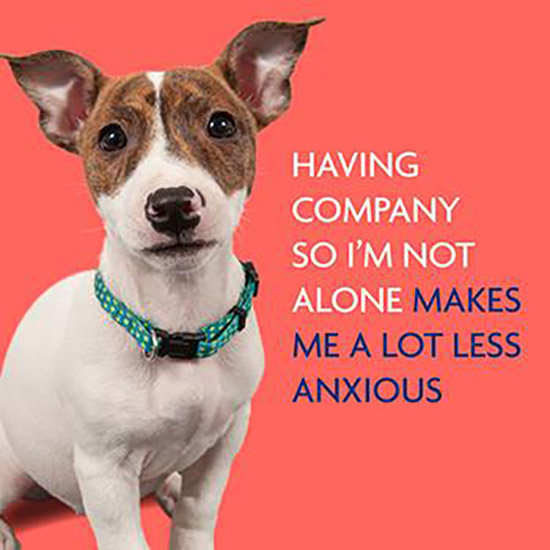Training your dog to be left alone
Learning to be left alone is an important part of your dog's training and will help prevent your dog from becoming anxious when they're left by themselves.
So if you've recently welcomed a dog or puppy into your family, it's really important to show them that being left at home is nothing to worry about.
Read on to discover how to prepare your dog and teach them that it's OK to be left alone.

Learning to be left alone
While some dogs are quite happy to be left alone for short periods, others may become distressed when separated from their owner. In fact research suggests that eight out of 10 dogs find it hard to cope when left alone. Yet, half won't show any obvious signs and so it can be easy for owners to miss. Contrary to popular belief, dogs are not doing this because they're trying to get ‘revenge’ on their owners for leaving them behind – in most cases, they're simply distressed about being separated from their owner.
Affected animals may bark, howl, go to the toilet indoors or be destructive when left alone. It may not be obvious that your dog becomes anxious when left alone. You may be completely unaware that your dog has been suffering unless you find evidence of destructive behaviour when you return home, or receive complaints from your neighbours about your dog’s barking.
It’s recommended that all owners try to video their dog when they are left alone from time to time, just to make sure that they're not showing a ‘hidden’ sign of distress, such as trembling, pacing about or whining.
Separation-related behaviour is a common reason for dogs to be handed over to rescue organisations, but it's important to remember that dogs rehomed from rescue centres are no more likely to develop this behaviour than dogs who come from other backgrounds.
There are a number of different reasons why a dog might show this type of behaviour so, if you notice signs that your dog is showing unsettled behaviour, you should talk to a vet who may refer you to a clinical animal behaviourist. A clinical behaviourist will be able to identify the underlying cause of the problem and treat it accordingly.
The length of time a dog can be left alone depends on the individual dog but we advise that they are left for no longer than four hours so they have opportunities to exercise, go to the toilet, and spend time with people. Studies have found that if you gradually introduce your dog to being left alone when they come to live with you, then you're less likely to have a problem later on.
Teaching your dog that it’s alright to be alone
One of the most effective ways of preventing your dog from ever becoming anxious when they're left alone is to teach them right from the start that being alone is fun! To do this you need to very gradually increase the time that you leave your dog alone so that it's never a frightening experience and always associated with something pleasant.
The speed that you progress will depend on your dog’s reaction. Never leave your dog so long that they start to become distressed.
Reward your dog for being relaxed when left alone – rewards can be toys, treats, or praise. A long-lasting treat is ideal as you can tell that your dog is worried if they leave something that they'd normally enjoy munching. If your dog becomes anxious and doesn't remain quietly in their bed eating the treat, don't offer a reward. Instead, simply go back a stage and try leaving them for a shorter period next time.
Repeat each of the following stages until you are sure your dog is happy before progressing. How quickly you progress depends on how well your dog responds.
- Start by encouraging your dog to go to their bed and stay there with you present for a short while. Reward your dog for remaining quietly in their bed.
- Next, ask your dog to stay in their bed as you move away, then return and reward.
- Move progressively further away and for longer. The distance/time that you increase by on each occasion will depend on your dog. If your dog reacts or moves, then don’t reward but go back to the previous stage.
- Start going out through the door before returning, then going out and shutting the door, then going out for longer periods of time. When you get to this point, start to vary the length of time that you're out.
- Once you reach the stage where your dog is happy to be left for up to an hour, you should then have no problems leaving them for longer periods. To avoid boredom, which may lead to mischief, remember to give your dog something to occupy them while you're out!
If you do have to go out and leave your dog for long periods of time as soon as you bring them home, arrange for friends or family to help out for a short while.
Stop your dog from becoming bored
There are a number of things that you can do to give your dog something to occupy themselves while you're away.
- Leave a safe, suitable toy with your dog when you go out. Make sure that this is a ‘special’ toy by only giving it to them when you go out or when they're separated from you in another room in the house.
- Try to leave something that your dog really loves such as a Kong toy stuffed with food (peanut butter or cheese mixed with dog biscuits are usually popular), or a meat-flavoured chew.
- Give your dog a treat ball or cube that you can fill with dried treats – so they will have to work to get them out.
- It’s important that any treats are taken out of your dog’s daily food allowance as overfeeding can lead to obesity, which can cause serious health and welfare concerns.
- Remember that when you return home, these ‘special’ items should be put away again and only given to your dog when you go out, or when you are in a different room in the house.
Feeding and exercise
Your dog will be more inclined to relax when left alone if they’ve had an appropriate amount of exercise and been fed before you go out.
- Try to always exercise your dog before leaving them.
- Take them for a walk, returning home half an hour before you are due to leave.
- Feed your dog a small meal shortly before leaving.
-
Always ensure your dog goes to the toilet before being left alone.
Avoid all punishment
If your dog misbehaves while you're out, it's vital that you don't react badly when you come home. Separation-related behaviour problems get worse when owners punish their dogs on their return.
This is because the punishment will be linked with your return, rather than the destruction, barking or toileting carried out some time previously. Your dog will then become anxious about what you'll do when you return the next time they're left alone. As a result of this increased anxiety the dog is more likely to chew or lose toilet control, making the problem even worse.
Dogs who've been told off in the past when their owners returned home frequently make themselves as small as possible, lowering their head, and putting their ears back and their tail between their legs. Unfortunately, owners often think that the dog looks guilty and punish them because they ‘know they’ve done wrong’. Even if you take your dog to 'the scene of the crime', they won't be able to associate your anger with their behaviour hours earlier – your dog will simply become more anxious the next time you go out.
The RSPCA only recommends the use of positive, reward-based training methods.
Although it's not easy, if you do find a mess when you come home, it is essential that you never physically punish or shout at your dog. Try to even avoid letting your dog see that you're annoyed – let them outside before cleaning up.
Top tip: If you struggle to implement these steps, remember that you're doing your best and that it's OK – separation-related anxiety is a complex issue. When this is the case our advice is always to seek support from a clinical behaviourist.
How to treat existing separation-related behaviour
If you believe that your dog is already showing signs of separation-related anxiety, find out what you can do to help them cope better when left alone.



